Criminal Law Essay: Crime, Education, and the Australian Context
VerifiedAdded on 2021/04/21
|10
|3048
|195
Essay
AI Summary
This essay delves into the complex relationship between education and crime within the framework of criminal law, focusing on the Australian context. It explores various arguments, including the potential of education for offenders to reduce crime rates by providing working skills, the cost-effectiveness of educational programs, and the handling of juvenile offenders. The essay also touches upon the merits and demerits of capital punishment, anti-social behavior, and the role of poverty and unemployment as precursors to crime. It concludes by asserting that increased education levels can have a significant impact on reducing crime rates, emphasizing the importance of implementing effective policies and alternative tools in the criminal justice system to ensure safer communities.
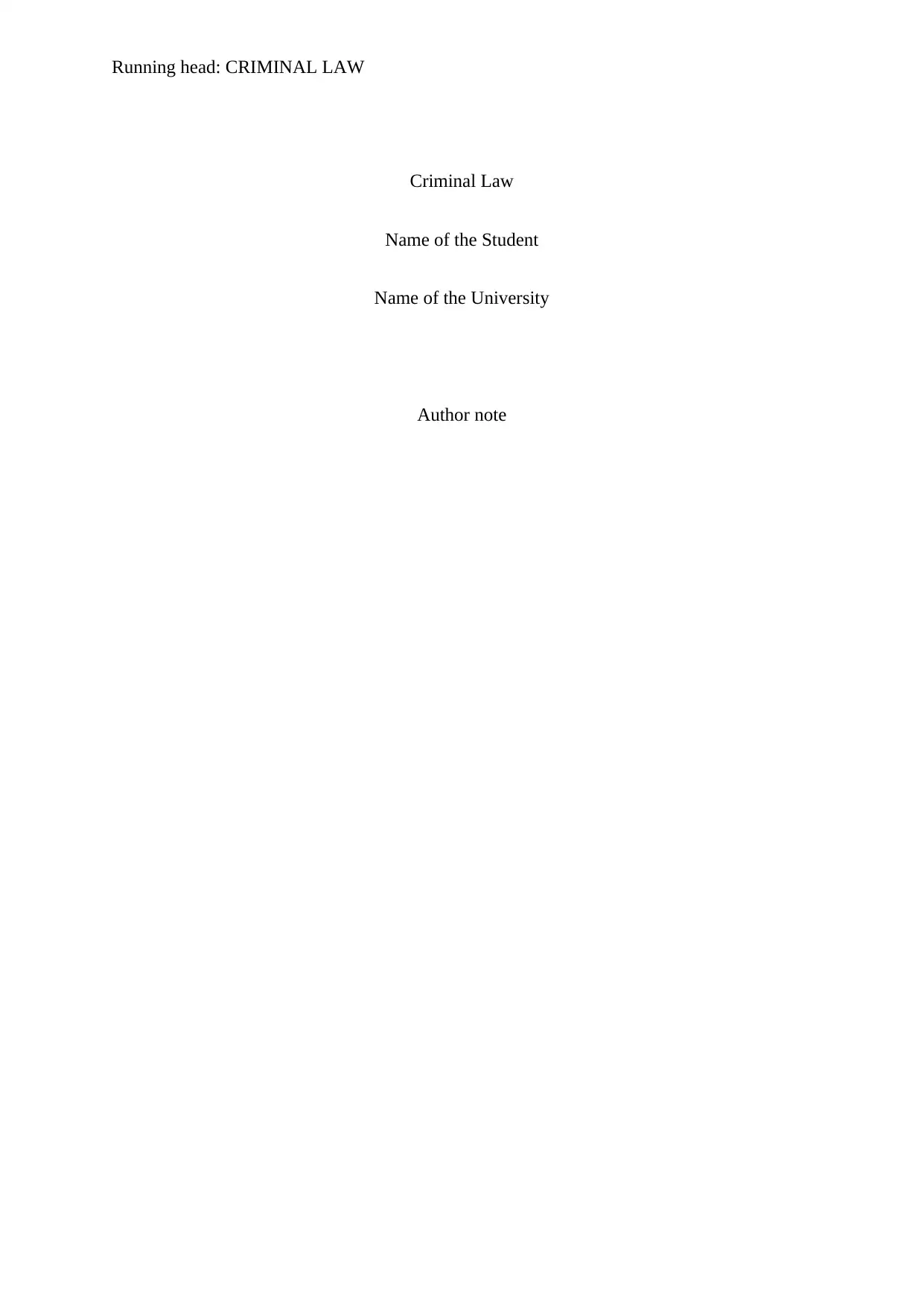
Running head: CRIMINAL LAW
Criminal Law
Name of the Student
Name of the University
Author note
Criminal Law
Name of the Student
Name of the University
Author note
Paraphrase This Document
Need a fresh take? Get an instant paraphrase of this document with our AI Paraphraser
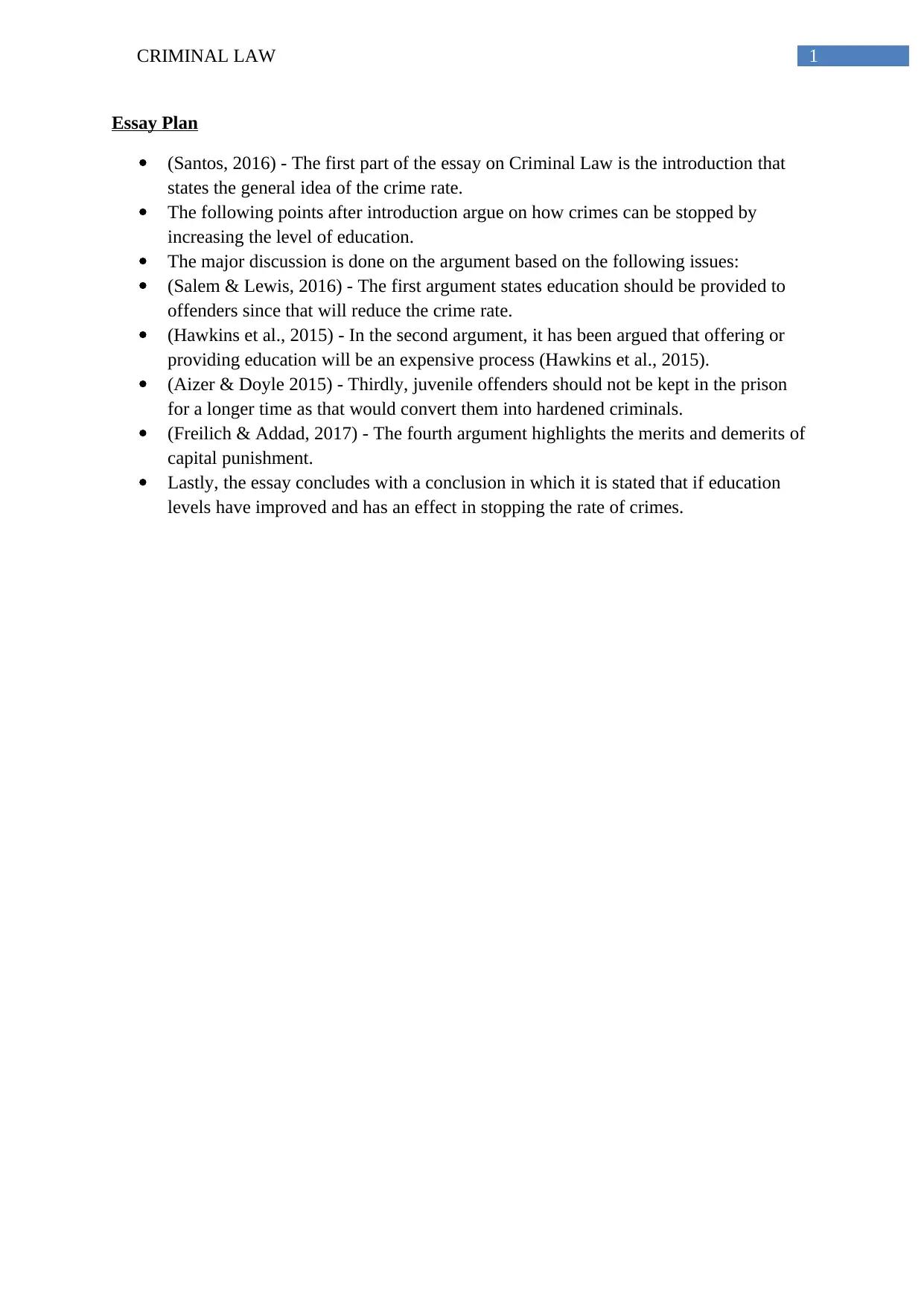
1CRIMINAL LAW
Essay Plan
(Santos, 2016) - The first part of the essay on Criminal Law is the introduction that
states the general idea of the crime rate.
The following points after introduction argue on how crimes can be stopped by
increasing the level of education.
The major discussion is done on the argument based on the following issues:
(Salem & Lewis, 2016) - The first argument states education should be provided to
offenders since that will reduce the crime rate.
(Hawkins et al., 2015) - In the second argument, it has been argued that offering or
providing education will be an expensive process (Hawkins et al., 2015).
(Aizer & Doyle 2015) - Thirdly, juvenile offenders should not be kept in the prison
for a longer time as that would convert them into hardened criminals.
(Freilich & Addad, 2017) - The fourth argument highlights the merits and demerits of
capital punishment.
Lastly, the essay concludes with a conclusion in which it is stated that if education
levels have improved and has an effect in stopping the rate of crimes.
Essay Plan
(Santos, 2016) - The first part of the essay on Criminal Law is the introduction that
states the general idea of the crime rate.
The following points after introduction argue on how crimes can be stopped by
increasing the level of education.
The major discussion is done on the argument based on the following issues:
(Salem & Lewis, 2016) - The first argument states education should be provided to
offenders since that will reduce the crime rate.
(Hawkins et al., 2015) - In the second argument, it has been argued that offering or
providing education will be an expensive process (Hawkins et al., 2015).
(Aizer & Doyle 2015) - Thirdly, juvenile offenders should not be kept in the prison
for a longer time as that would convert them into hardened criminals.
(Freilich & Addad, 2017) - The fourth argument highlights the merits and demerits of
capital punishment.
Lastly, the essay concludes with a conclusion in which it is stated that if education
levels have improved and has an effect in stopping the rate of crimes.
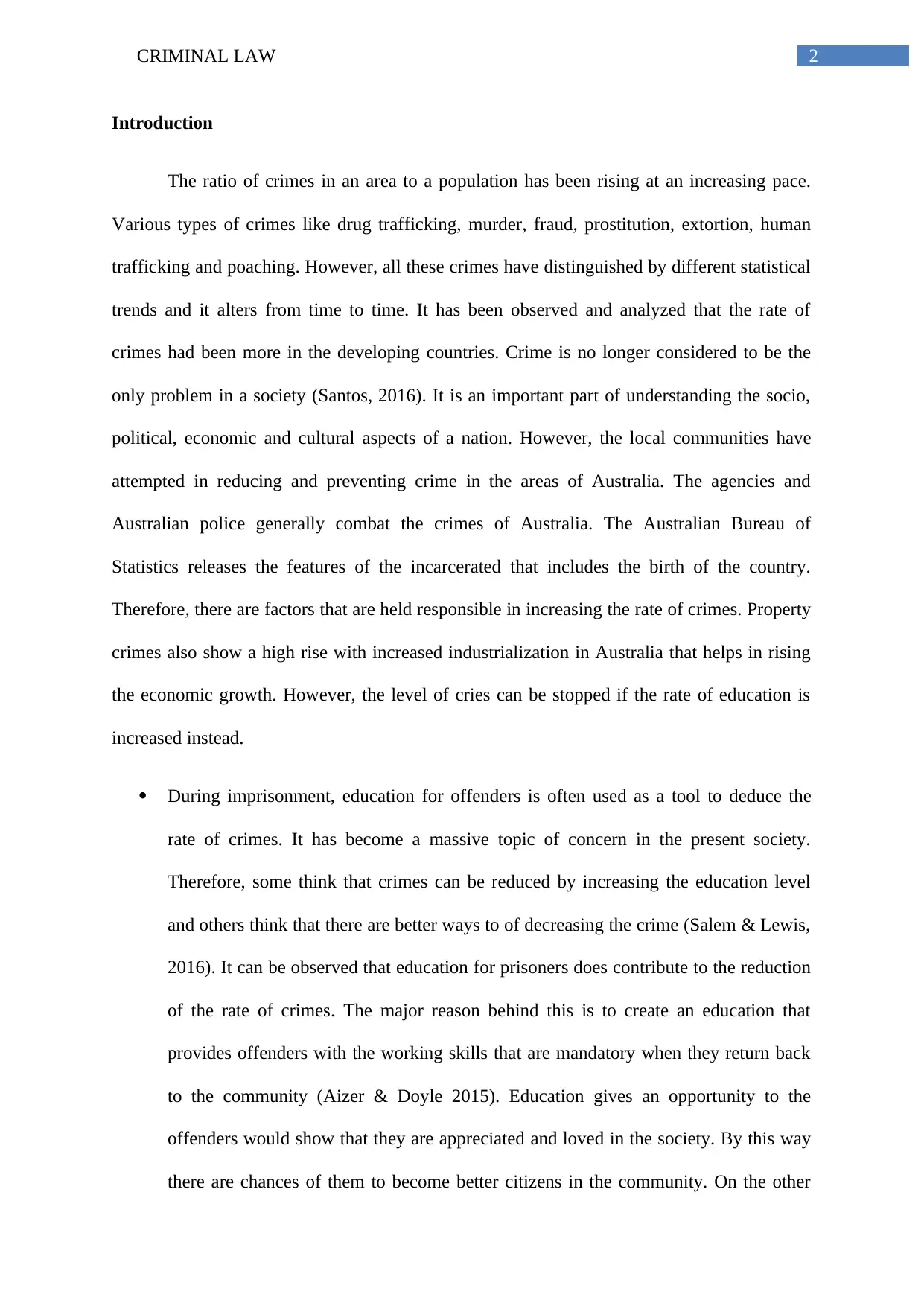
2CRIMINAL LAW
Introduction
The ratio of crimes in an area to a population has been rising at an increasing pace.
Various types of crimes like drug trafficking, murder, fraud, prostitution, extortion, human
trafficking and poaching. However, all these crimes have distinguished by different statistical
trends and it alters from time to time. It has been observed and analyzed that the rate of
crimes had been more in the developing countries. Crime is no longer considered to be the
only problem in a society (Santos, 2016). It is an important part of understanding the socio,
political, economic and cultural aspects of a nation. However, the local communities have
attempted in reducing and preventing crime in the areas of Australia. The agencies and
Australian police generally combat the crimes of Australia. The Australian Bureau of
Statistics releases the features of the incarcerated that includes the birth of the country.
Therefore, there are factors that are held responsible in increasing the rate of crimes. Property
crimes also show a high rise with increased industrialization in Australia that helps in rising
the economic growth. However, the level of cries can be stopped if the rate of education is
increased instead.
During imprisonment, education for offenders is often used as a tool to deduce the
rate of crimes. It has become a massive topic of concern in the present society.
Therefore, some think that crimes can be reduced by increasing the education level
and others think that there are better ways to of decreasing the crime (Salem & Lewis,
2016). It can be observed that education for prisoners does contribute to the reduction
of the rate of crimes. The major reason behind this is to create an education that
provides offenders with the working skills that are mandatory when they return back
to the community (Aizer & Doyle 2015). Education gives an opportunity to the
offenders would show that they are appreciated and loved in the society. By this way
there are chances of them to become better citizens in the community. On the other
Introduction
The ratio of crimes in an area to a population has been rising at an increasing pace.
Various types of crimes like drug trafficking, murder, fraud, prostitution, extortion, human
trafficking and poaching. However, all these crimes have distinguished by different statistical
trends and it alters from time to time. It has been observed and analyzed that the rate of
crimes had been more in the developing countries. Crime is no longer considered to be the
only problem in a society (Santos, 2016). It is an important part of understanding the socio,
political, economic and cultural aspects of a nation. However, the local communities have
attempted in reducing and preventing crime in the areas of Australia. The agencies and
Australian police generally combat the crimes of Australia. The Australian Bureau of
Statistics releases the features of the incarcerated that includes the birth of the country.
Therefore, there are factors that are held responsible in increasing the rate of crimes. Property
crimes also show a high rise with increased industrialization in Australia that helps in rising
the economic growth. However, the level of cries can be stopped if the rate of education is
increased instead.
During imprisonment, education for offenders is often used as a tool to deduce the
rate of crimes. It has become a massive topic of concern in the present society.
Therefore, some think that crimes can be reduced by increasing the education level
and others think that there are better ways to of decreasing the crime (Salem & Lewis,
2016). It can be observed that education for prisoners does contribute to the reduction
of the rate of crimes. The major reason behind this is to create an education that
provides offenders with the working skills that are mandatory when they return back
to the community (Aizer & Doyle 2015). Education gives an opportunity to the
offenders would show that they are appreciated and loved in the society. By this way
there are chances of them to become better citizens in the community. On the other
⊘ This is a preview!⊘
Do you want full access?
Subscribe today to unlock all pages.

Trusted by 1+ million students worldwide
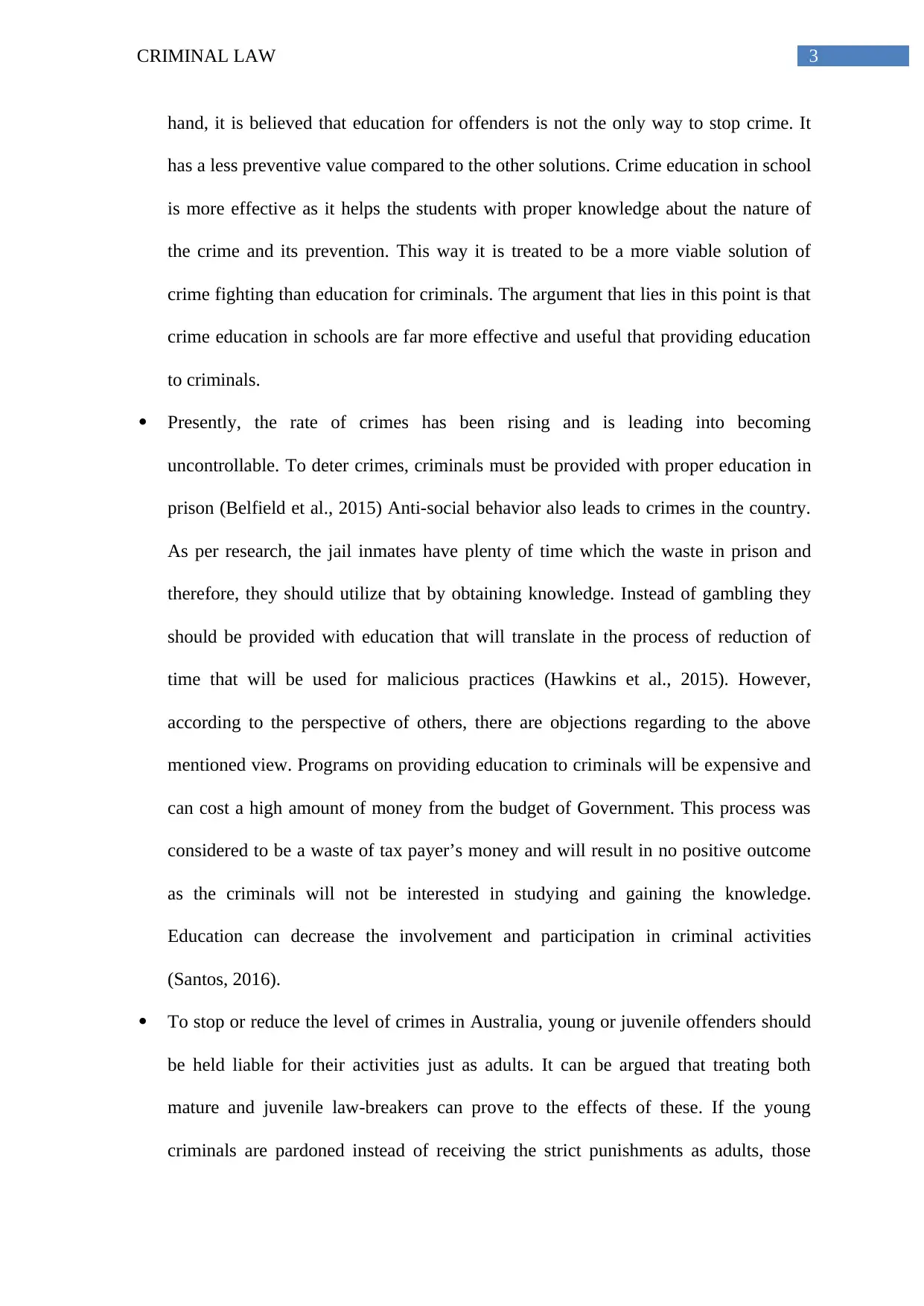
3CRIMINAL LAW
hand, it is believed that education for offenders is not the only way to stop crime. It
has a less preventive value compared to the other solutions. Crime education in school
is more effective as it helps the students with proper knowledge about the nature of
the crime and its prevention. This way it is treated to be a more viable solution of
crime fighting than education for criminals. The argument that lies in this point is that
crime education in schools are far more effective and useful that providing education
to criminals.
Presently, the rate of crimes has been rising and is leading into becoming
uncontrollable. To deter crimes, criminals must be provided with proper education in
prison (Belfield et al., 2015) Anti-social behavior also leads to crimes in the country.
As per research, the jail inmates have plenty of time which the waste in prison and
therefore, they should utilize that by obtaining knowledge. Instead of gambling they
should be provided with education that will translate in the process of reduction of
time that will be used for malicious practices (Hawkins et al., 2015). However,
according to the perspective of others, there are objections regarding to the above
mentioned view. Programs on providing education to criminals will be expensive and
can cost a high amount of money from the budget of Government. This process was
considered to be a waste of tax payer’s money and will result in no positive outcome
as the criminals will not be interested in studying and gaining the knowledge.
Education can decrease the involvement and participation in criminal activities
(Santos, 2016).
To stop or reduce the level of crimes in Australia, young or juvenile offenders should
be held liable for their activities just as adults. It can be argued that treating both
mature and juvenile law-breakers can prove to the effects of these. If the young
criminals are pardoned instead of receiving the strict punishments as adults, those
hand, it is believed that education for offenders is not the only way to stop crime. It
has a less preventive value compared to the other solutions. Crime education in school
is more effective as it helps the students with proper knowledge about the nature of
the crime and its prevention. This way it is treated to be a more viable solution of
crime fighting than education for criminals. The argument that lies in this point is that
crime education in schools are far more effective and useful that providing education
to criminals.
Presently, the rate of crimes has been rising and is leading into becoming
uncontrollable. To deter crimes, criminals must be provided with proper education in
prison (Belfield et al., 2015) Anti-social behavior also leads to crimes in the country.
As per research, the jail inmates have plenty of time which the waste in prison and
therefore, they should utilize that by obtaining knowledge. Instead of gambling they
should be provided with education that will translate in the process of reduction of
time that will be used for malicious practices (Hawkins et al., 2015). However,
according to the perspective of others, there are objections regarding to the above
mentioned view. Programs on providing education to criminals will be expensive and
can cost a high amount of money from the budget of Government. This process was
considered to be a waste of tax payer’s money and will result in no positive outcome
as the criminals will not be interested in studying and gaining the knowledge.
Education can decrease the involvement and participation in criminal activities
(Santos, 2016).
To stop or reduce the level of crimes in Australia, young or juvenile offenders should
be held liable for their activities just as adults. It can be argued that treating both
mature and juvenile law-breakers can prove to the effects of these. If the young
criminals are pardoned instead of receiving the strict punishments as adults, those
Paraphrase This Document
Need a fresh take? Get an instant paraphrase of this document with our AI Paraphraser
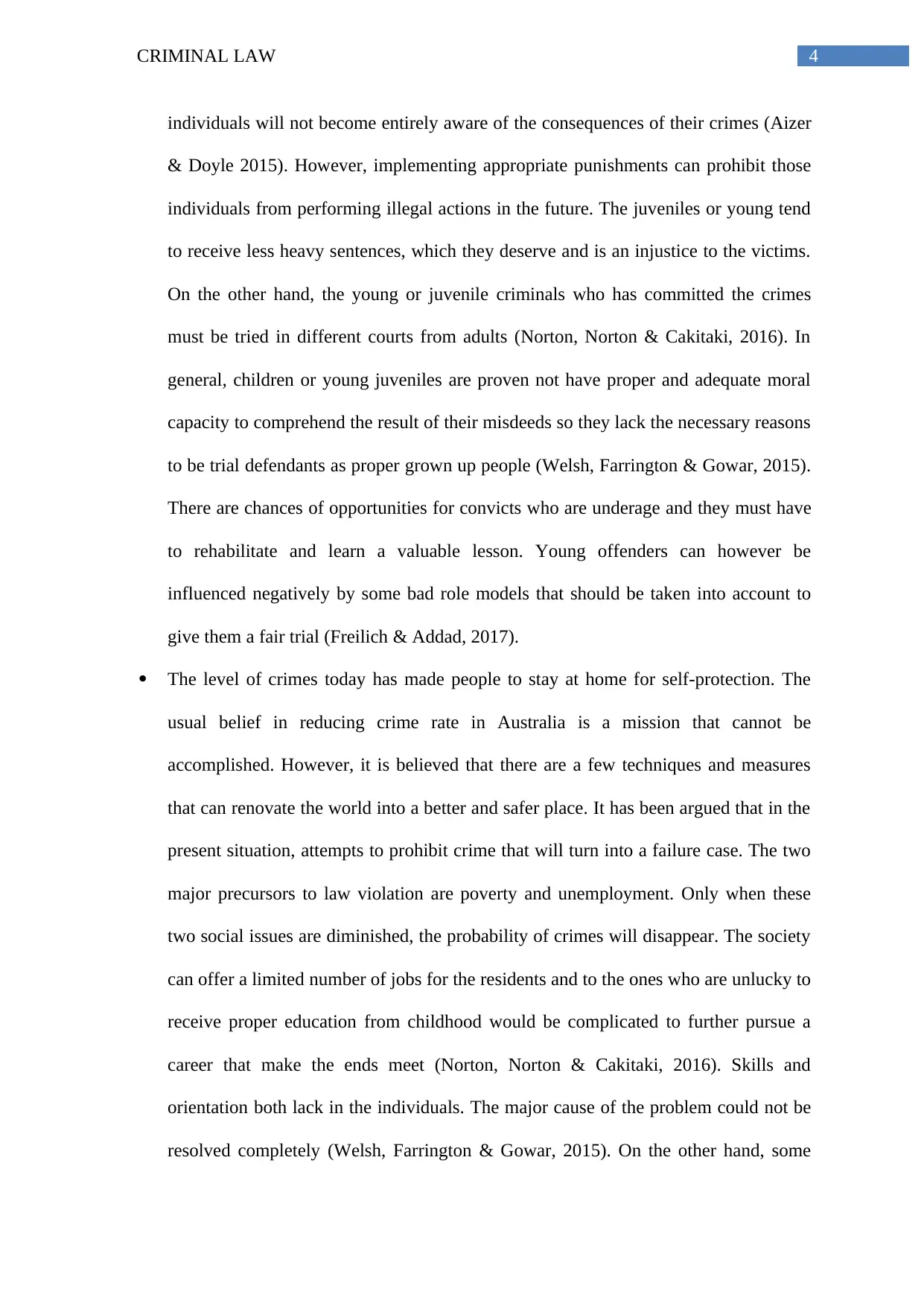
4CRIMINAL LAW
individuals will not become entirely aware of the consequences of their crimes (Aizer
& Doyle 2015). However, implementing appropriate punishments can prohibit those
individuals from performing illegal actions in the future. The juveniles or young tend
to receive less heavy sentences, which they deserve and is an injustice to the victims.
On the other hand, the young or juvenile criminals who has committed the crimes
must be tried in different courts from adults (Norton, Norton & Cakitaki, 2016). In
general, children or young juveniles are proven not have proper and adequate moral
capacity to comprehend the result of their misdeeds so they lack the necessary reasons
to be trial defendants as proper grown up people (Welsh, Farrington & Gowar, 2015).
There are chances of opportunities for convicts who are underage and they must have
to rehabilitate and learn a valuable lesson. Young offenders can however be
influenced negatively by some bad role models that should be taken into account to
give them a fair trial (Freilich & Addad, 2017).
The level of crimes today has made people to stay at home for self-protection. The
usual belief in reducing crime rate in Australia is a mission that cannot be
accomplished. However, it is believed that there are a few techniques and measures
that can renovate the world into a better and safer place. It has been argued that in the
present situation, attempts to prohibit crime that will turn into a failure case. The two
major precursors to law violation are poverty and unemployment. Only when these
two social issues are diminished, the probability of crimes will disappear. The society
can offer a limited number of jobs for the residents and to the ones who are unlucky to
receive proper education from childhood would be complicated to further pursue a
career that make the ends meet (Norton, Norton & Cakitaki, 2016). Skills and
orientation both lack in the individuals. The major cause of the problem could not be
resolved completely (Welsh, Farrington & Gowar, 2015). On the other hand, some
individuals will not become entirely aware of the consequences of their crimes (Aizer
& Doyle 2015). However, implementing appropriate punishments can prohibit those
individuals from performing illegal actions in the future. The juveniles or young tend
to receive less heavy sentences, which they deserve and is an injustice to the victims.
On the other hand, the young or juvenile criminals who has committed the crimes
must be tried in different courts from adults (Norton, Norton & Cakitaki, 2016). In
general, children or young juveniles are proven not have proper and adequate moral
capacity to comprehend the result of their misdeeds so they lack the necessary reasons
to be trial defendants as proper grown up people (Welsh, Farrington & Gowar, 2015).
There are chances of opportunities for convicts who are underage and they must have
to rehabilitate and learn a valuable lesson. Young offenders can however be
influenced negatively by some bad role models that should be taken into account to
give them a fair trial (Freilich & Addad, 2017).
The level of crimes today has made people to stay at home for self-protection. The
usual belief in reducing crime rate in Australia is a mission that cannot be
accomplished. However, it is believed that there are a few techniques and measures
that can renovate the world into a better and safer place. It has been argued that in the
present situation, attempts to prohibit crime that will turn into a failure case. The two
major precursors to law violation are poverty and unemployment. Only when these
two social issues are diminished, the probability of crimes will disappear. The society
can offer a limited number of jobs for the residents and to the ones who are unlucky to
receive proper education from childhood would be complicated to further pursue a
career that make the ends meet (Norton, Norton & Cakitaki, 2016). Skills and
orientation both lack in the individuals. The major cause of the problem could not be
resolved completely (Welsh, Farrington & Gowar, 2015). On the other hand, some
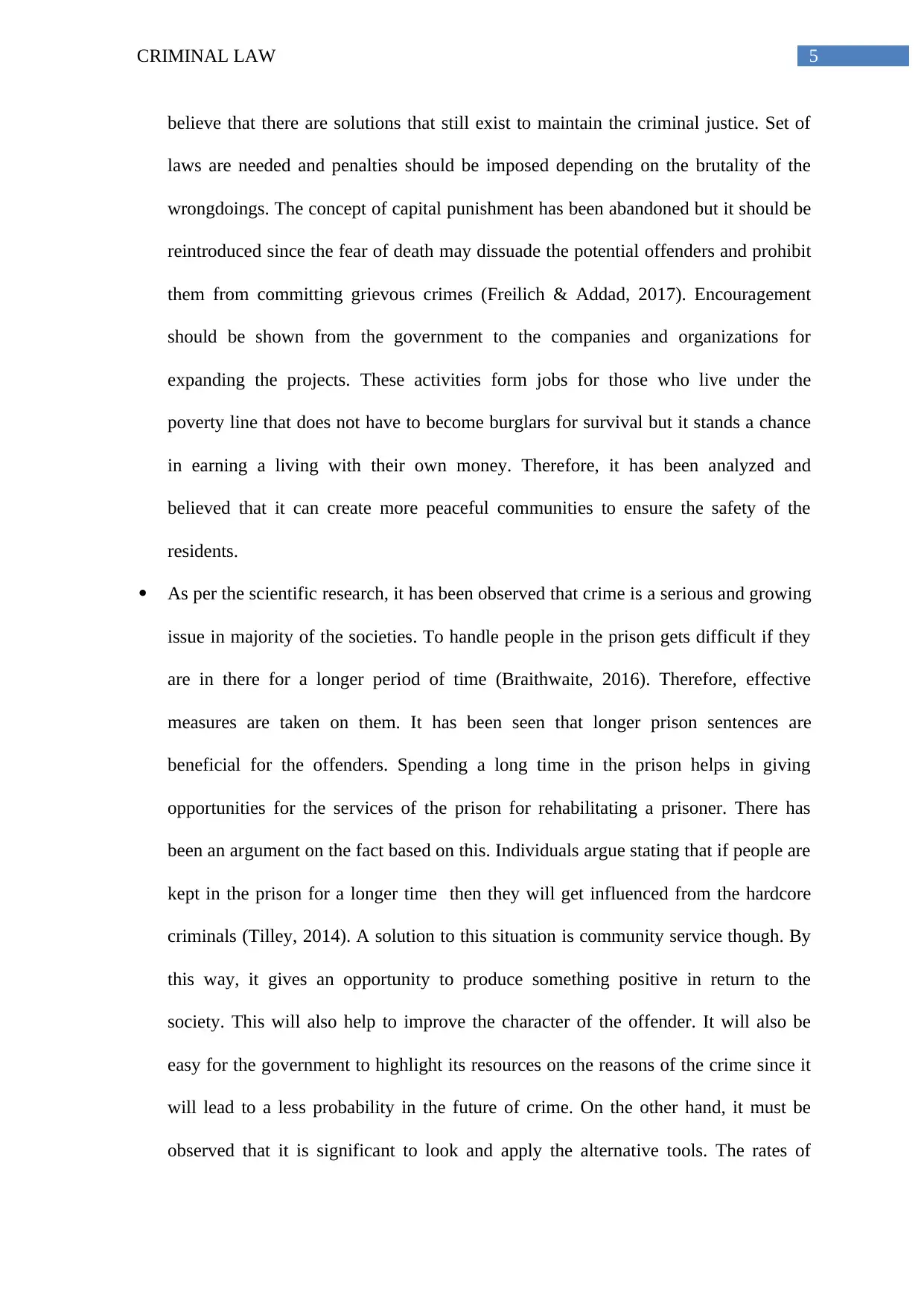
5CRIMINAL LAW
believe that there are solutions that still exist to maintain the criminal justice. Set of
laws are needed and penalties should be imposed depending on the brutality of the
wrongdoings. The concept of capital punishment has been abandoned but it should be
reintroduced since the fear of death may dissuade the potential offenders and prohibit
them from committing grievous crimes (Freilich & Addad, 2017). Encouragement
should be shown from the government to the companies and organizations for
expanding the projects. These activities form jobs for those who live under the
poverty line that does not have to become burglars for survival but it stands a chance
in earning a living with their own money. Therefore, it has been analyzed and
believed that it can create more peaceful communities to ensure the safety of the
residents.
As per the scientific research, it has been observed that crime is a serious and growing
issue in majority of the societies. To handle people in the prison gets difficult if they
are in there for a longer period of time (Braithwaite, 2016). Therefore, effective
measures are taken on them. It has been seen that longer prison sentences are
beneficial for the offenders. Spending a long time in the prison helps in giving
opportunities for the services of the prison for rehabilitating a prisoner. There has
been an argument on the fact based on this. Individuals argue stating that if people are
kept in the prison for a longer time then they will get influenced from the hardcore
criminals (Tilley, 2014). A solution to this situation is community service though. By
this way, it gives an opportunity to produce something positive in return to the
society. This will also help to improve the character of the offender. It will also be
easy for the government to highlight its resources on the reasons of the crime since it
will lead to a less probability in the future of crime. On the other hand, it must be
observed that it is significant to look and apply the alternative tools. The rates of
believe that there are solutions that still exist to maintain the criminal justice. Set of
laws are needed and penalties should be imposed depending on the brutality of the
wrongdoings. The concept of capital punishment has been abandoned but it should be
reintroduced since the fear of death may dissuade the potential offenders and prohibit
them from committing grievous crimes (Freilich & Addad, 2017). Encouragement
should be shown from the government to the companies and organizations for
expanding the projects. These activities form jobs for those who live under the
poverty line that does not have to become burglars for survival but it stands a chance
in earning a living with their own money. Therefore, it has been analyzed and
believed that it can create more peaceful communities to ensure the safety of the
residents.
As per the scientific research, it has been observed that crime is a serious and growing
issue in majority of the societies. To handle people in the prison gets difficult if they
are in there for a longer period of time (Braithwaite, 2016). Therefore, effective
measures are taken on them. It has been seen that longer prison sentences are
beneficial for the offenders. Spending a long time in the prison helps in giving
opportunities for the services of the prison for rehabilitating a prisoner. There has
been an argument on the fact based on this. Individuals argue stating that if people are
kept in the prison for a longer time then they will get influenced from the hardcore
criminals (Tilley, 2014). A solution to this situation is community service though. By
this way, it gives an opportunity to produce something positive in return to the
society. This will also help to improve the character of the offender. It will also be
easy for the government to highlight its resources on the reasons of the crime since it
will lead to a less probability in the future of crime. On the other hand, it must be
observed that it is significant to look and apply the alternative tools. The rates of
⊘ This is a preview!⊘
Do you want full access?
Subscribe today to unlock all pages.

Trusted by 1+ million students worldwide
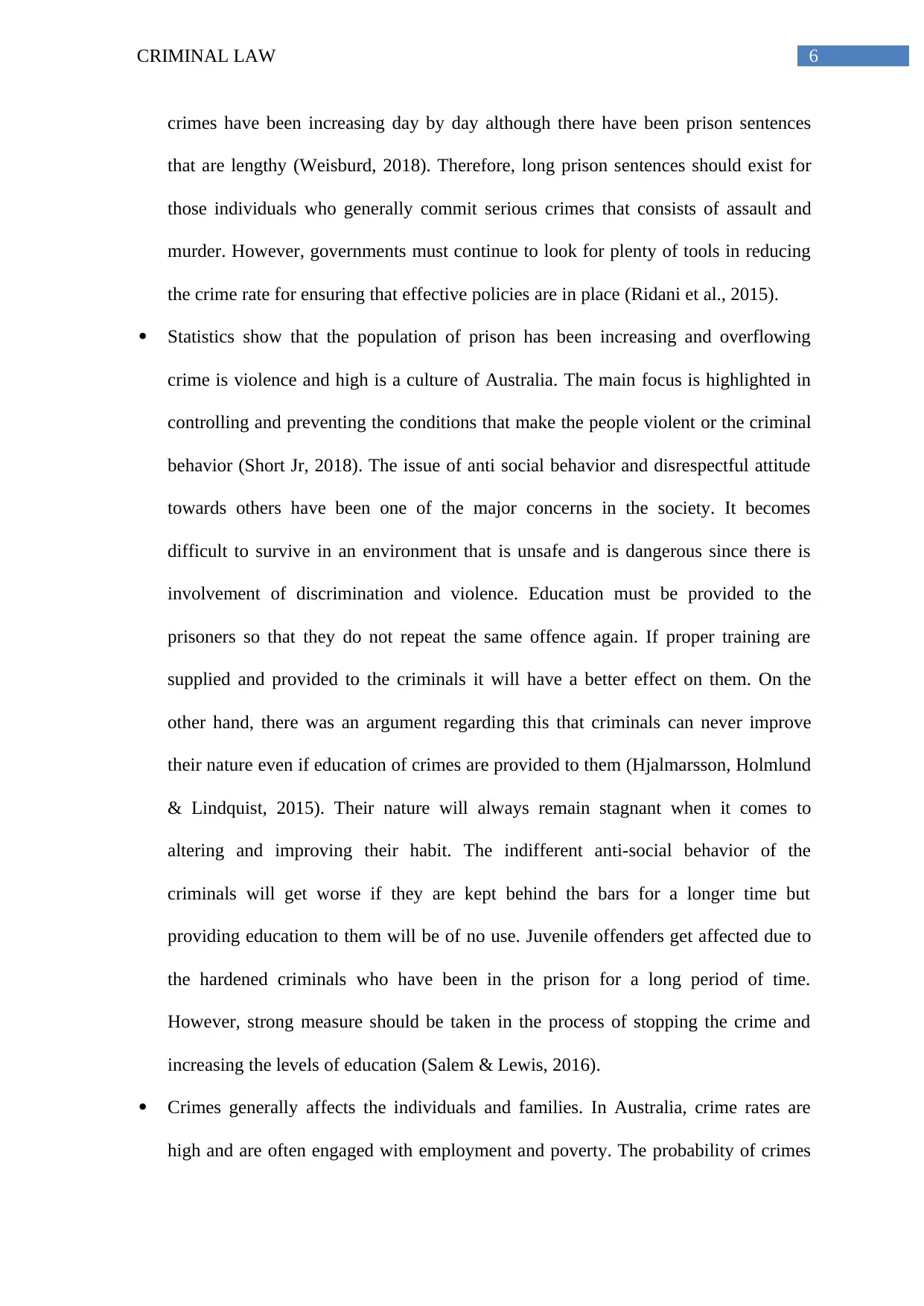
6CRIMINAL LAW
crimes have been increasing day by day although there have been prison sentences
that are lengthy (Weisburd, 2018). Therefore, long prison sentences should exist for
those individuals who generally commit serious crimes that consists of assault and
murder. However, governments must continue to look for plenty of tools in reducing
the crime rate for ensuring that effective policies are in place (Ridani et al., 2015).
Statistics show that the population of prison has been increasing and overflowing
crime is violence and high is a culture of Australia. The main focus is highlighted in
controlling and preventing the conditions that make the people violent or the criminal
behavior (Short Jr, 2018). The issue of anti social behavior and disrespectful attitude
towards others have been one of the major concerns in the society. It becomes
difficult to survive in an environment that is unsafe and is dangerous since there is
involvement of discrimination and violence. Education must be provided to the
prisoners so that they do not repeat the same offence again. If proper training are
supplied and provided to the criminals it will have a better effect on them. On the
other hand, there was an argument regarding this that criminals can never improve
their nature even if education of crimes are provided to them (Hjalmarsson, Holmlund
& Lindquist, 2015). Their nature will always remain stagnant when it comes to
altering and improving their habit. The indifferent anti-social behavior of the
criminals will get worse if they are kept behind the bars for a longer time but
providing education to them will be of no use. Juvenile offenders get affected due to
the hardened criminals who have been in the prison for a long period of time.
However, strong measure should be taken in the process of stopping the crime and
increasing the levels of education (Salem & Lewis, 2016).
Crimes generally affects the individuals and families. In Australia, crime rates are
high and are often engaged with employment and poverty. The probability of crimes
crimes have been increasing day by day although there have been prison sentences
that are lengthy (Weisburd, 2018). Therefore, long prison sentences should exist for
those individuals who generally commit serious crimes that consists of assault and
murder. However, governments must continue to look for plenty of tools in reducing
the crime rate for ensuring that effective policies are in place (Ridani et al., 2015).
Statistics show that the population of prison has been increasing and overflowing
crime is violence and high is a culture of Australia. The main focus is highlighted in
controlling and preventing the conditions that make the people violent or the criminal
behavior (Short Jr, 2018). The issue of anti social behavior and disrespectful attitude
towards others have been one of the major concerns in the society. It becomes
difficult to survive in an environment that is unsafe and is dangerous since there is
involvement of discrimination and violence. Education must be provided to the
prisoners so that they do not repeat the same offence again. If proper training are
supplied and provided to the criminals it will have a better effect on them. On the
other hand, there was an argument regarding this that criminals can never improve
their nature even if education of crimes are provided to them (Hjalmarsson, Holmlund
& Lindquist, 2015). Their nature will always remain stagnant when it comes to
altering and improving their habit. The indifferent anti-social behavior of the
criminals will get worse if they are kept behind the bars for a longer time but
providing education to them will be of no use. Juvenile offenders get affected due to
the hardened criminals who have been in the prison for a long period of time.
However, strong measure should be taken in the process of stopping the crime and
increasing the levels of education (Salem & Lewis, 2016).
Crimes generally affects the individuals and families. In Australia, crime rates are
high and are often engaged with employment and poverty. The probability of crimes
Paraphrase This Document
Need a fresh take? Get an instant paraphrase of this document with our AI Paraphraser
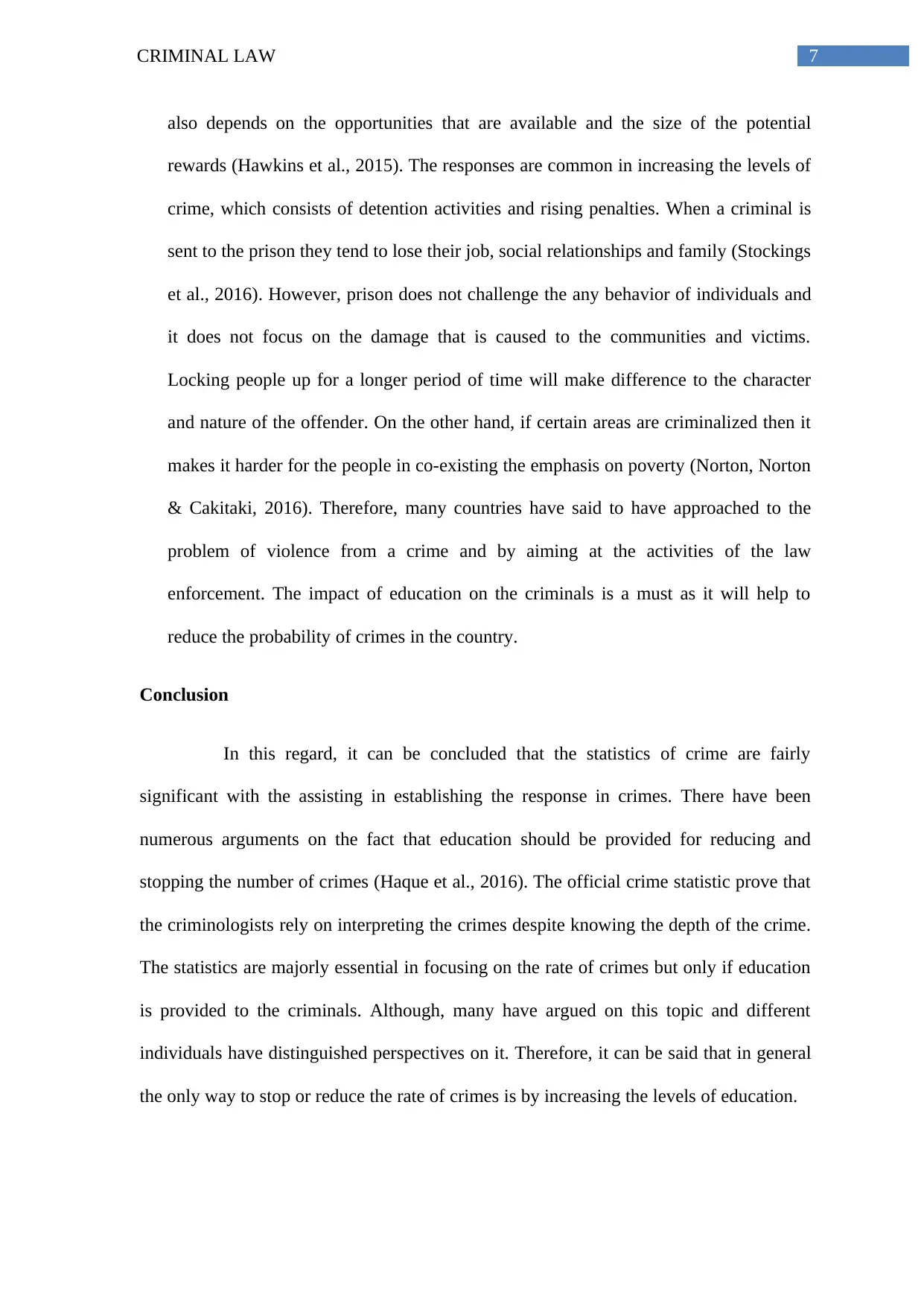
7CRIMINAL LAW
also depends on the opportunities that are available and the size of the potential
rewards (Hawkins et al., 2015). The responses are common in increasing the levels of
crime, which consists of detention activities and rising penalties. When a criminal is
sent to the prison they tend to lose their job, social relationships and family (Stockings
et al., 2016). However, prison does not challenge the any behavior of individuals and
it does not focus on the damage that is caused to the communities and victims.
Locking people up for a longer period of time will make difference to the character
and nature of the offender. On the other hand, if certain areas are criminalized then it
makes it harder for the people in co-existing the emphasis on poverty (Norton, Norton
& Cakitaki, 2016). Therefore, many countries have said to have approached to the
problem of violence from a crime and by aiming at the activities of the law
enforcement. The impact of education on the criminals is a must as it will help to
reduce the probability of crimes in the country.
Conclusion
In this regard, it can be concluded that the statistics of crime are fairly
significant with the assisting in establishing the response in crimes. There have been
numerous arguments on the fact that education should be provided for reducing and
stopping the number of crimes (Haque et al., 2016). The official crime statistic prove that
the criminologists rely on interpreting the crimes despite knowing the depth of the crime.
The statistics are majorly essential in focusing on the rate of crimes but only if education
is provided to the criminals. Although, many have argued on this topic and different
individuals have distinguished perspectives on it. Therefore, it can be said that in general
the only way to stop or reduce the rate of crimes is by increasing the levels of education.
also depends on the opportunities that are available and the size of the potential
rewards (Hawkins et al., 2015). The responses are common in increasing the levels of
crime, which consists of detention activities and rising penalties. When a criminal is
sent to the prison they tend to lose their job, social relationships and family (Stockings
et al., 2016). However, prison does not challenge the any behavior of individuals and
it does not focus on the damage that is caused to the communities and victims.
Locking people up for a longer period of time will make difference to the character
and nature of the offender. On the other hand, if certain areas are criminalized then it
makes it harder for the people in co-existing the emphasis on poverty (Norton, Norton
& Cakitaki, 2016). Therefore, many countries have said to have approached to the
problem of violence from a crime and by aiming at the activities of the law
enforcement. The impact of education on the criminals is a must as it will help to
reduce the probability of crimes in the country.
Conclusion
In this regard, it can be concluded that the statistics of crime are fairly
significant with the assisting in establishing the response in crimes. There have been
numerous arguments on the fact that education should be provided for reducing and
stopping the number of crimes (Haque et al., 2016). The official crime statistic prove that
the criminologists rely on interpreting the crimes despite knowing the depth of the crime.
The statistics are majorly essential in focusing on the rate of crimes but only if education
is provided to the criminals. Although, many have argued on this topic and different
individuals have distinguished perspectives on it. Therefore, it can be said that in general
the only way to stop or reduce the rate of crimes is by increasing the levels of education.
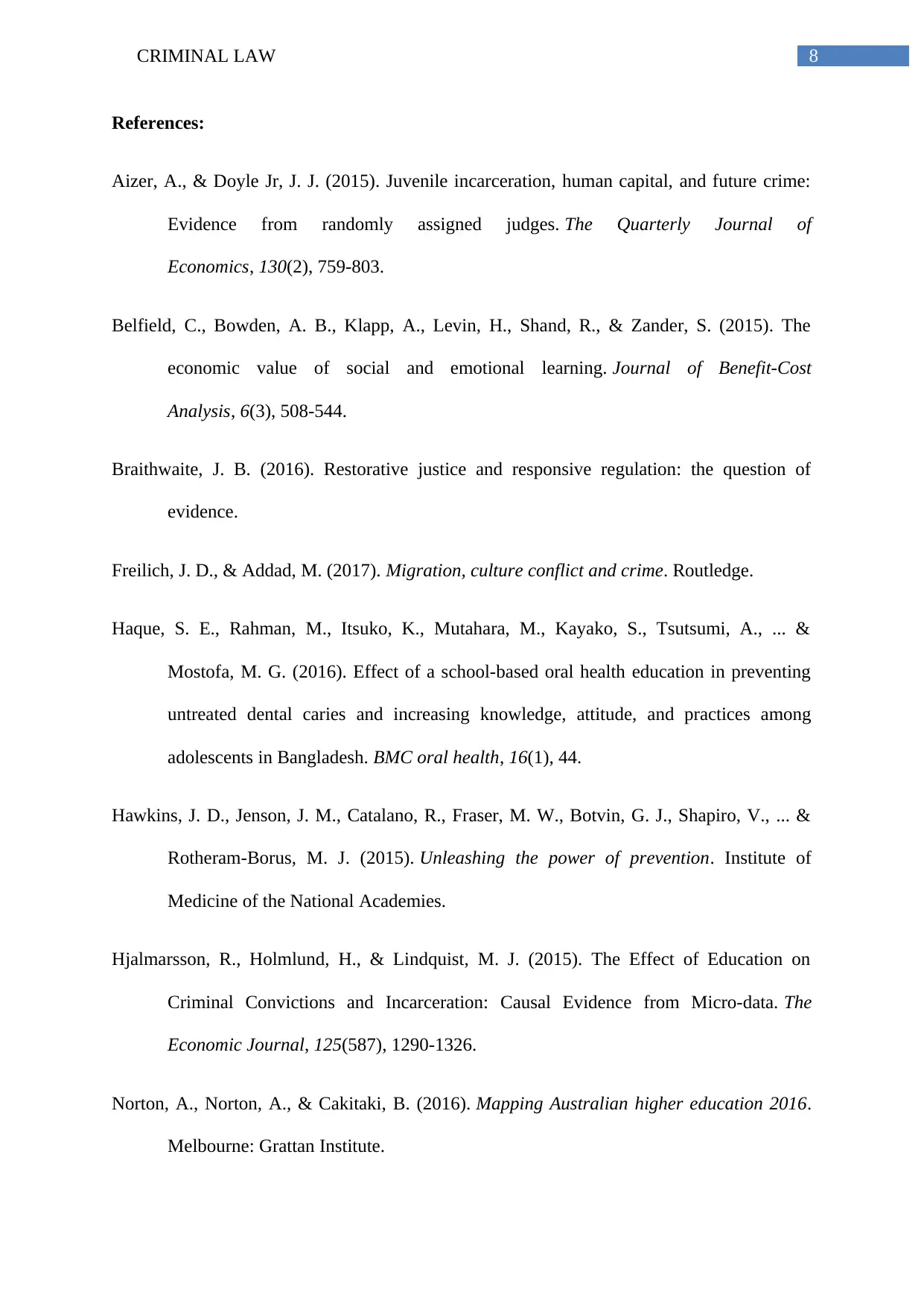
8CRIMINAL LAW
References:
Aizer, A., & Doyle Jr, J. J. (2015). Juvenile incarceration, human capital, and future crime:
Evidence from randomly assigned judges. The Quarterly Journal of
Economics, 130(2), 759-803.
Belfield, C., Bowden, A. B., Klapp, A., Levin, H., Shand, R., & Zander, S. (2015). The
economic value of social and emotional learning. Journal of Benefit-Cost
Analysis, 6(3), 508-544.
Braithwaite, J. B. (2016). Restorative justice and responsive regulation: the question of
evidence.
Freilich, J. D., & Addad, M. (2017). Migration, culture conflict and crime. Routledge.
Haque, S. E., Rahman, M., Itsuko, K., Mutahara, M., Kayako, S., Tsutsumi, A., ... &
Mostofa, M. G. (2016). Effect of a school-based oral health education in preventing
untreated dental caries and increasing knowledge, attitude, and practices among
adolescents in Bangladesh. BMC oral health, 16(1), 44.
Hawkins, J. D., Jenson, J. M., Catalano, R., Fraser, M. W., Botvin, G. J., Shapiro, V., ... &
Rotheram-Borus, M. J. (2015). Unleashing the power of prevention. Institute of
Medicine of the National Academies.
Hjalmarsson, R., Holmlund, H., & Lindquist, M. J. (2015). The Effect of Education on
Criminal Convictions and Incarceration: Causal Evidence from Micro‐data. The
Economic Journal, 125(587), 1290-1326.
Norton, A., Norton, A., & Cakitaki, B. (2016). Mapping Australian higher education 2016.
Melbourne: Grattan Institute.
References:
Aizer, A., & Doyle Jr, J. J. (2015). Juvenile incarceration, human capital, and future crime:
Evidence from randomly assigned judges. The Quarterly Journal of
Economics, 130(2), 759-803.
Belfield, C., Bowden, A. B., Klapp, A., Levin, H., Shand, R., & Zander, S. (2015). The
economic value of social and emotional learning. Journal of Benefit-Cost
Analysis, 6(3), 508-544.
Braithwaite, J. B. (2016). Restorative justice and responsive regulation: the question of
evidence.
Freilich, J. D., & Addad, M. (2017). Migration, culture conflict and crime. Routledge.
Haque, S. E., Rahman, M., Itsuko, K., Mutahara, M., Kayako, S., Tsutsumi, A., ... &
Mostofa, M. G. (2016). Effect of a school-based oral health education in preventing
untreated dental caries and increasing knowledge, attitude, and practices among
adolescents in Bangladesh. BMC oral health, 16(1), 44.
Hawkins, J. D., Jenson, J. M., Catalano, R., Fraser, M. W., Botvin, G. J., Shapiro, V., ... &
Rotheram-Borus, M. J. (2015). Unleashing the power of prevention. Institute of
Medicine of the National Academies.
Hjalmarsson, R., Holmlund, H., & Lindquist, M. J. (2015). The Effect of Education on
Criminal Convictions and Incarceration: Causal Evidence from Micro‐data. The
Economic Journal, 125(587), 1290-1326.
Norton, A., Norton, A., & Cakitaki, B. (2016). Mapping Australian higher education 2016.
Melbourne: Grattan Institute.
⊘ This is a preview!⊘
Do you want full access?
Subscribe today to unlock all pages.

Trusted by 1+ million students worldwide
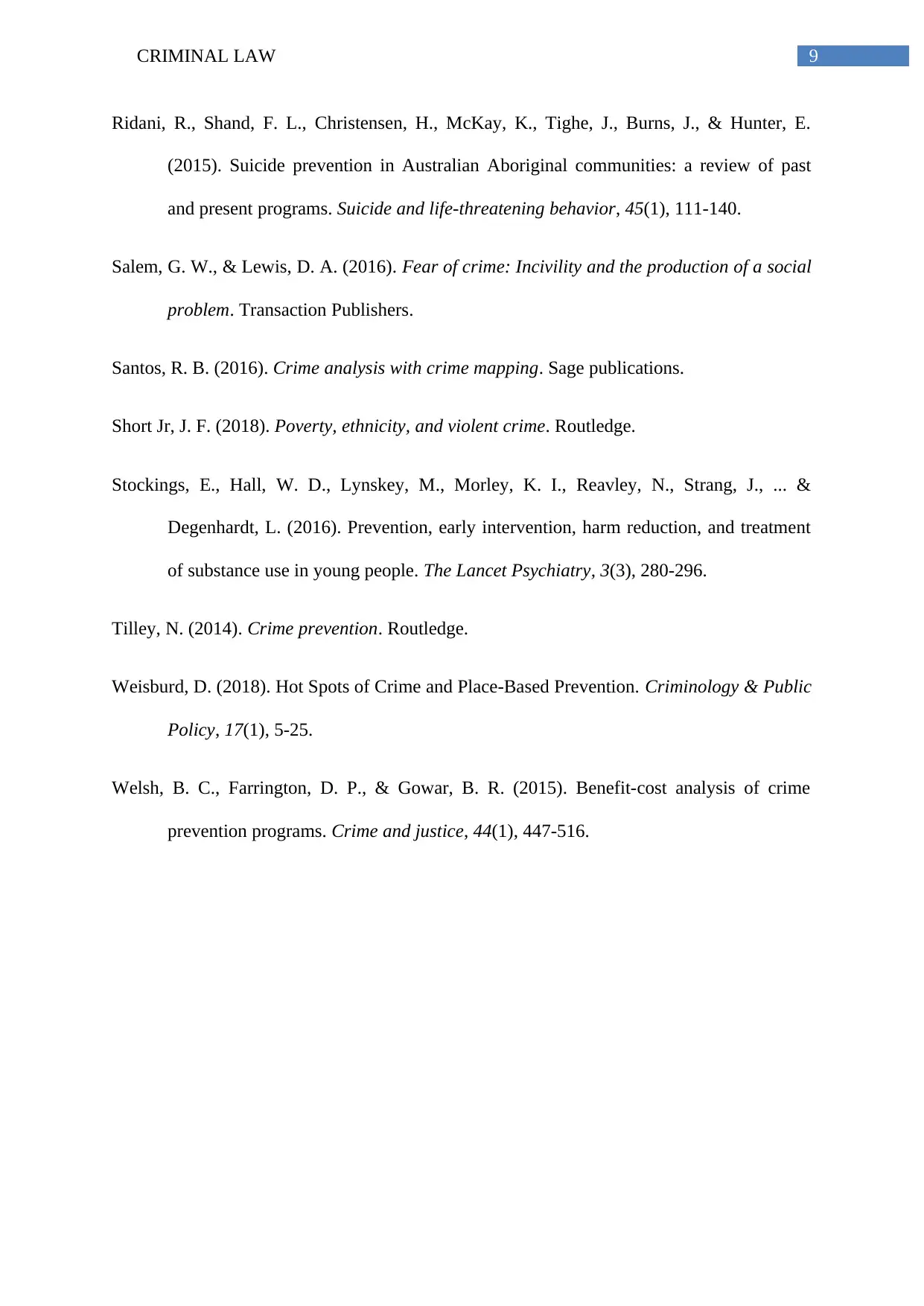
9CRIMINAL LAW
Ridani, R., Shand, F. L., Christensen, H., McKay, K., Tighe, J., Burns, J., & Hunter, E.
(2015). Suicide prevention in Australian Aboriginal communities: a review of past
and present programs. Suicide and life-threatening behavior, 45(1), 111-140.
Salem, G. W., & Lewis, D. A. (2016). Fear of crime: Incivility and the production of a social
problem. Transaction Publishers.
Santos, R. B. (2016). Crime analysis with crime mapping. Sage publications.
Short Jr, J. F. (2018). Poverty, ethnicity, and violent crime. Routledge.
Stockings, E., Hall, W. D., Lynskey, M., Morley, K. I., Reavley, N., Strang, J., ... &
Degenhardt, L. (2016). Prevention, early intervention, harm reduction, and treatment
of substance use in young people. The Lancet Psychiatry, 3(3), 280-296.
Tilley, N. (2014). Crime prevention. Routledge.
Weisburd, D. (2018). Hot Spots of Crime and Place‐Based Prevention. Criminology & Public
Policy, 17(1), 5-25.
Welsh, B. C., Farrington, D. P., & Gowar, B. R. (2015). Benefit-cost analysis of crime
prevention programs. Crime and justice, 44(1), 447-516.
Ridani, R., Shand, F. L., Christensen, H., McKay, K., Tighe, J., Burns, J., & Hunter, E.
(2015). Suicide prevention in Australian Aboriginal communities: a review of past
and present programs. Suicide and life-threatening behavior, 45(1), 111-140.
Salem, G. W., & Lewis, D. A. (2016). Fear of crime: Incivility and the production of a social
problem. Transaction Publishers.
Santos, R. B. (2016). Crime analysis with crime mapping. Sage publications.
Short Jr, J. F. (2018). Poverty, ethnicity, and violent crime. Routledge.
Stockings, E., Hall, W. D., Lynskey, M., Morley, K. I., Reavley, N., Strang, J., ... &
Degenhardt, L. (2016). Prevention, early intervention, harm reduction, and treatment
of substance use in young people. The Lancet Psychiatry, 3(3), 280-296.
Tilley, N. (2014). Crime prevention. Routledge.
Weisburd, D. (2018). Hot Spots of Crime and Place‐Based Prevention. Criminology & Public
Policy, 17(1), 5-25.
Welsh, B. C., Farrington, D. P., & Gowar, B. R. (2015). Benefit-cost analysis of crime
prevention programs. Crime and justice, 44(1), 447-516.
1 out of 10
Your All-in-One AI-Powered Toolkit for Academic Success.
+13062052269
info@desklib.com
Available 24*7 on WhatsApp / Email
![[object Object]](/_next/static/media/star-bottom.7253800d.svg)
Unlock your academic potential
Copyright © 2020–2025 A2Z Services. All Rights Reserved. Developed and managed by ZUCOL.


